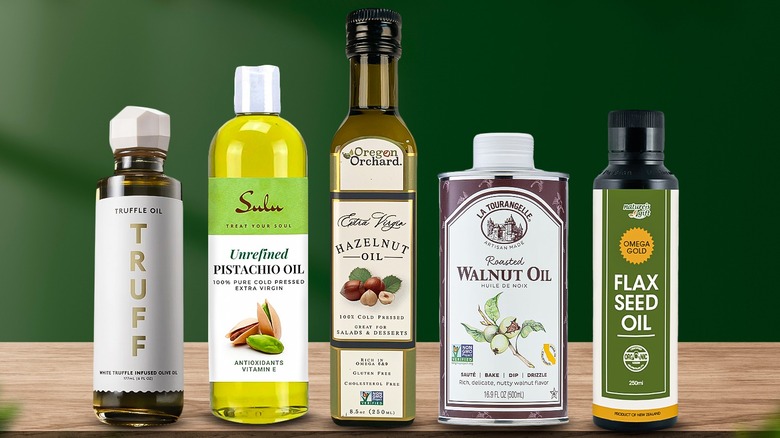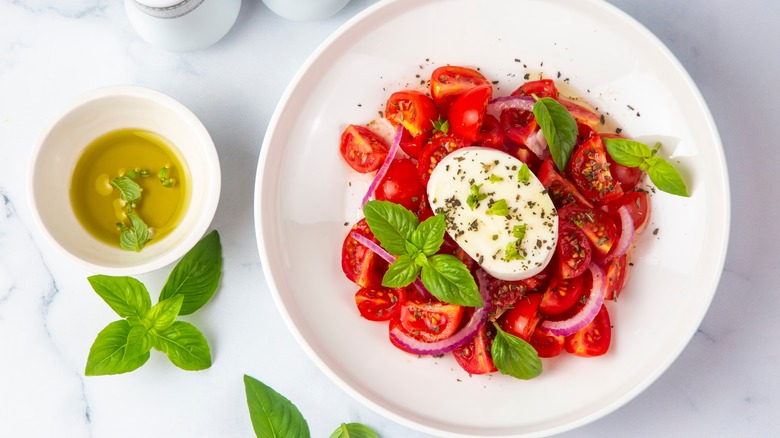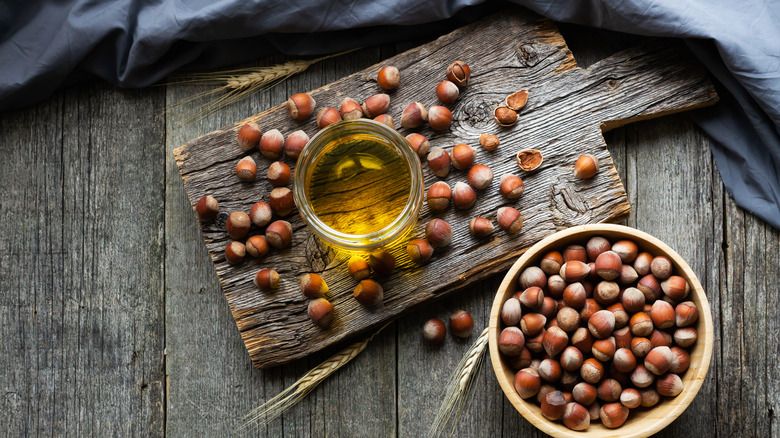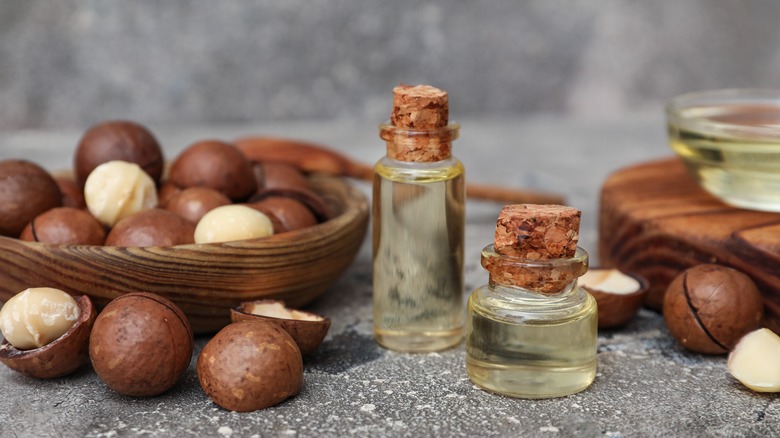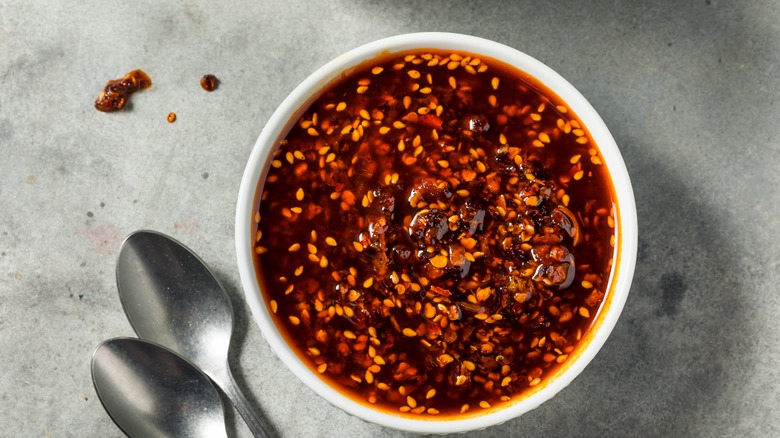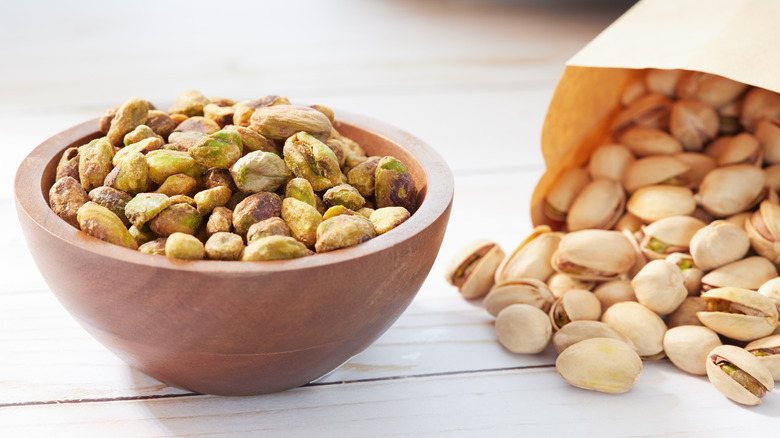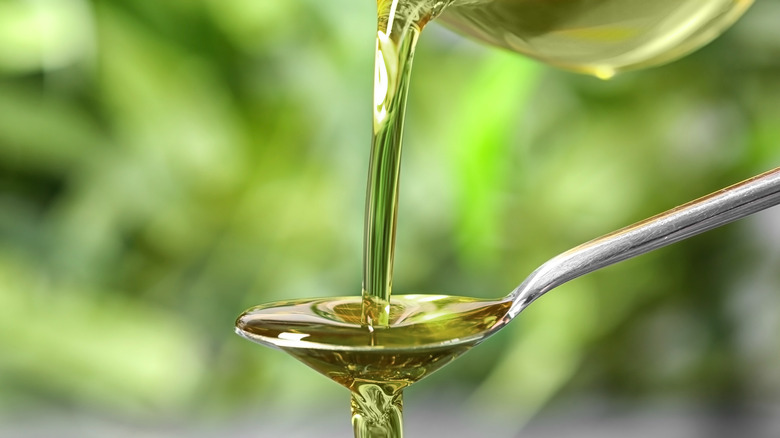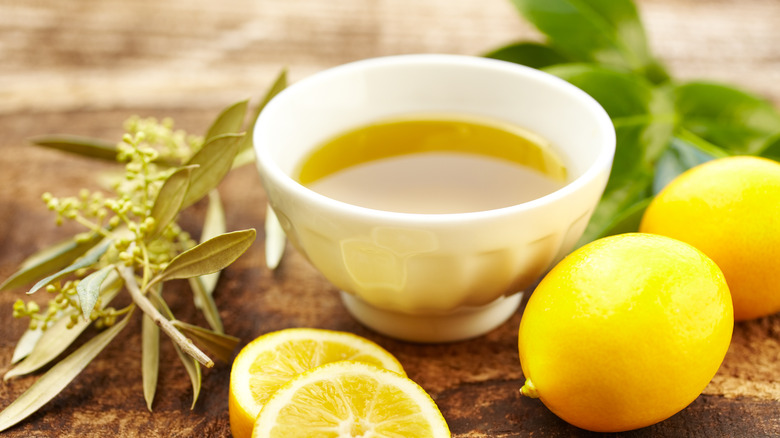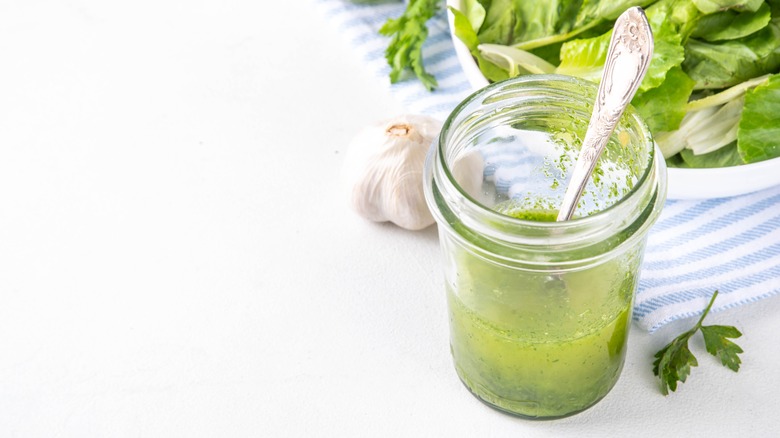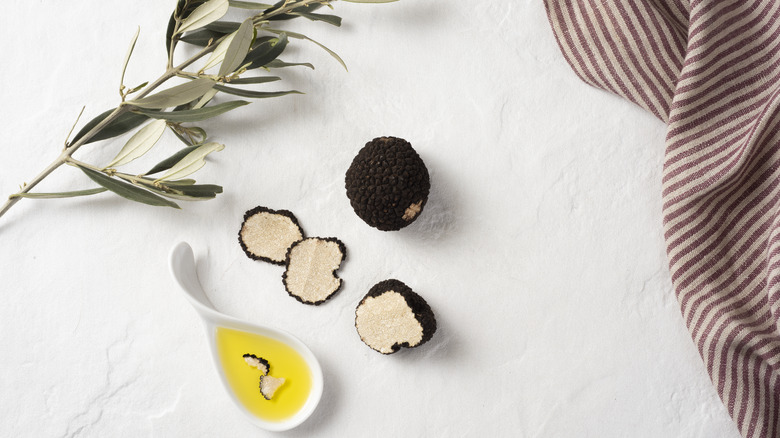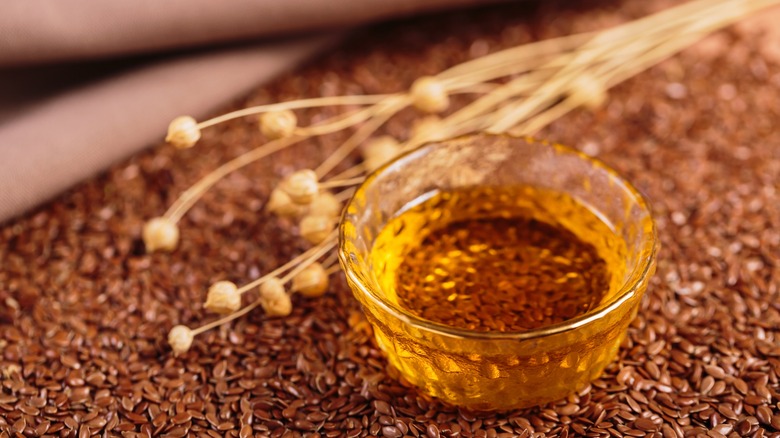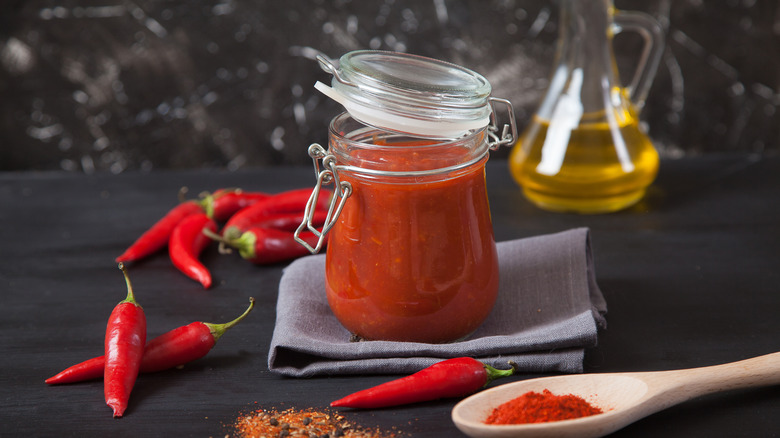15 Best Finishing Oils And When To Use Them
There are some aisles in the grocery store that are quite formidable — like the bread aisle (seriously, how many brands of white sandwich bread do you really need?), the frozen potato aisle (isn't seven different fry shapes kind of excessive?), and the topic of conversation today: the oil aisle. Not only are there so many different brands of olive and canola oil, but there are so many different types of oils themselves to select from.
Let us break it down for you. There are two categories of oils you'll find in this aisle: cooking oils and finishing oils. Cooking oils are meant to be functional; they don't do much in the way of flavor, but their high smoke point makes them a great fit for frying chicken, adding to a brownie recipe, and the like. The finishing oils are more like the nexus between flavor and functionality. While you can't use them for high-heat cooking (nor would you want to, as they're quite expensive compared to canola, rapeseed, or vegetable oil), they are a great way to add extra flavor to your recipe right before you're about to plate it. In order to help you select between different types of finishing oils, we've done some research as to their best applications, as well as any important considerations you should keep in mind when using them.
Extra virgin olive oil
We start off with the unequivocal workhorse of the finishing oil world: extra virgin olive oil (EVOO). While it might not have the same punch or allure of additions like garlic, harissa, or lemon, when you find a good olive oil brand, you keep it close to the chest.
Extra virgin olive oil is the finishing oil that many folks across different cuisines are most familiar with. While some folks use plain olive oil for cooking and frying, EVOO is a quality distinction. The quality and high price point of this oil are related to its processing — or lack thereof. It's unrefined, meaning that it's not treated with any chemicals or extracting compounds. EVOO, as a result, tends to be a bit darker in color and grassier in flavor. You may also see some EVOOs marketed as being "cold-pressed;" this refers to the conditions by which the oil is extracted from the olive.
Like other finishing oils, the smoke point of EVOO is comparatively low; you'll want to reserve the cheaper and more refined olive oil for cooking. When you crack open a bottle of EVOO to drizzle over your fresh Caprese salad or to toss your pasta with, it should have a fragrant, fresh-from-the-garden flavor. Though, all olive oils will taste slightly different, so you're best off tasting a few to find one that you like.
Hazelnut oil
Hazelnuts may be an ingredient you more commonly associate with a jar of Nutella than with a finishing oil. But, once you try it, you'll see why hazelnut oil is an ingredient that you want to keep in your pantry at all times and dress up your dishes with.
Hazelnut oil, unlike many of the fats on this list, is suitable to use both as a finishing oil and for cooking. It has a smoke point of around 430 degrees Fahrenheit, which means that you can use it for most of your culinary tasks. This oil has a flavor that's similar to sesame oil, with stronger sweet notes and a more delectable nuttiness. Its flavor makes it one type of oil that's tricky to work with, as you most likely only want to impart a slight hazelnut flavor and aroma to your dish rather than walloping the whole thing with it. If you find the flavor and pungency of this finishing oil to be overwhelming, you may want to try cutting it with a bit of extra virgin olive oil before you turn it into a salad dressing.
Sunflower oil
Sunflower oil is more common than you might think. Chances are that you can find a bottle of it among the generic canola and vegetable oils in your local grocery store. This type of sunflower oil is refined, which means that it is stripped of all of its flavor. But, if you can get your hands on a bottle of unrefined sunflower oil, then you might consider using it as a finishing oil to dress up some of your favorite salads, breads, and more.
As is expected, unrefined sunflower oil retains that distinctive, nutty profile of sunflower seeds. Its flavor has also been described as buttery, so it would lend itself well to both sweet and savory dishes. Unrefined sunflower oil really shines in a salad dressing; consider pairing it with some lemon juice, garlic, and fresh herbs for a basic vinaigrette that will easily upgrade everything from a tossed green salad to panzanella.
Macadamia nut oil
Macadamia nuts are a food that not many folks are familiar with — except for the occasional white chocolate macadamia nut cookie. But, one other derivative from this tropical nut is macadamia nut oil. Its flavor is light, buttery, and the perfect pairing for an array of dishes. For example, you may want to swap out some of the olive oil in a recipe for shishito and macadamia romesco with roasted vegetables — or just stick to using the oil to dress the veggies.
The slightly nutty and sweet profile of macadamia nut oil also makes it a great addition to an olive oil cake. Oil cakes are traditionally much more dense than cakes made with butter, but they are just so delicious that you can excuse some momentary heaviness. The olive oil doesn't really do much for the flavor of this cake, while the macadamia nut oil will. Pair it with lightening ingredients, like a bit of citrus zest, to help elevate this cake and balance out the oil's richness.
Garlic oil
Garlic oil is a delicious addition to any kitchen, especially if you find yourself cooking a ton of Italian food. You can toss your freshly cooked pasta in it to add some sharp, allium-y flavor, or you may want to use it in place of regular olive oil in a pesto to highlight the garlic notes a bit more.
While you can purchase a bottle of garlic-infused olive oil from the store, many folks will try to make their own to cut down on costs. But, according to the United States Department of Agriculture, suspending garlic in oil and leaving it at room temperature opens up the opportunity for botulism to flourish. These toxins do not alter the flavor of the oil itself, which means that you could accidentally make yourself sick by consuming it. In order to avoid this risk, Michigan State University Extension recommends storing the oil in the fridge and using it within a few days of making it.
Walnut oil
Walnuts have a delicate but still pungent flavor. The oil derived from the nuts is also praised for its high nutritional benefits, including its omega-3 fatty acids and potential to decrease inflammation and improve skin health.
Unlike many of the other finishing oils on this list, walnut oil can be used for more than just savory dishes. You should always have this oil in your pantry because you can drizzle it on everything from roasted root vegetables to bread. Rich and flavorful beets, turnips, and carrots would be a great complement to the nutty and buttery walnut flavor. You could also add it to all of the dishes where you'd normally put walnuts. For one, you may consider adding walnut oil to banana bread to replace some of the butter; the flavor would mesh well with the sweet fruit and other additions like chocolate chips or autumnal spices.
Chili oil
Some like it hot, and for those people, there is the lovely stuff we know as chili oil. The exact recipe will vary depending on where you buy it from (or how you make it yourself). But, there are usually some standard ingredients that have been steeped or cooked with a neutral oil, like dried peppers and garlic.
It's an excellent ingredient to give your meat marinades a kick. The aromatics, combined with spices like ginger and five-spice powder, will elevate steaks, pork, or even tofu. Granted, the cooking and heating process will turn some of this heat down. So, if you like to get that piquantness on your lips, you might want to add a drizzle of this oil to the protein after it's finished cooking.
Another application for this powerful oil is on a bowl of ramen. The oil would add some distinct brightness to your broth that would help round out its flavors. Moreover, food isn't the only spot where chili oil has a home; consider using it to upgrade your next batch of spicy margaritas.
Pistachio oil
For the folks who find pleasure in using all of their might to crack pistachios right out of their shells, there's pistachio oil. It's far less work, and you'll get far more flavor from this concentrated oil. While other nuts, like macadamias, walnuts, and hazelnuts, lean buttery and heavy, the pistachio is delectably grassy and floral. We'd recommend drizzling a little bit on a high-quality vanilla ice cream to get a better sense of its flavor. It also pairs well with fresh fruits; you may want to try tossing fresh-from-the-garden blueberries or raspberries with it and serving it alongside a scoop of homemade whipped cream.
Pistachio oil works best in recipes that allow its herbaceousness to shine. That's why you may want to try adding it to a vinaigrette and serving it on a salad. It pairs exceptionally well with bland meats, like chicken, as well as some types of cheeses, like Parmesan, goat, and ricotta. Combine your protein with greens, cheese, and a pistachio oil vinaigrette and you have a formula for success.
Hemp seed oil
Hemp seed oil is a relative newcomer to the finishing oil scene. It's often associated with CBD oil, which boasts several different potential health benefits — though the two are totally different products. CBD oil is predominately used medicinally, while hemp seed oil has more culinary applications. Hemp seed oil also doesn't have any psychoactive properties (like THC oil), nor does it contain any CBD.
Some folks have described the taste of hemp oil as similar to walnut oil — nutty but also buttery — so it's reasonable to see how you can use it in some of the same applications. Serve it alongside some warm dinner rolls for dipping or use it to dress a woodsy, flavorful pasta with chunks of tomato and mozzarella in it. You'll just want to avoid cooking or heating up this oil in any capacity, as its smoke point is only at 325 degrees Fahrenheit
Lemon oil
It's hard to say no to a flavorful, lemon-infused meal or dessert. But, did you know that you can pack all of the complexities of this citrus into an oil? Although you would think that you would have to use lemon juice to make lemon oil, that's far from the case. Rather, the oil is concentrated from the peels — there's no actual oil or juice involved.
As you could imagine, lemon oil is pungent — like, a-single-drop-could-make-your-whole-house-smell-like-Pledge pungent. So, you'll need to be very mindful and thoughtful about when and how you add it to your recipes. Overall, fruity baked goods will benefit from a little bit of lemon oil. Think about adding a hint of it to a raspberry or blueberry crisp to heighten the berry flavor, or using it to flavor a vanilla cake mix. You could also add it to an ice cream recipe to restore some flavor balance and highlight those vanilla bean flavors. Don't be afraid, though, to experiment with it and savory profiles, too. It could elevate a simple sauce for your chicken or be used as a simple dressing for grilled salmon.
Herb oil
Herb oil is a great way to infuse all of your favorite fresh flavors, like parsley, cilantro, and tarragon, into a spread that's easily drizzlable. The herbs are combined with high-quality olive oil in a container; then, they're left to infuse over time. It's recommended that you blanch the herbs right before you blend them with the oil, as this will ensure that their color remains super bright. You should also stick to leafy, soft herbs — so skip the stems of rosemary and thyme. The fact that you can use herb oil as a recycling bin for your leftovers is great news for folks who tend to stock up on fresh herbs only for them to go bad in the back of the fridge.
The exact flavor profile of your herb oil will depend on what you're using for it. But in general, this oil can be a great addition to soups (like a warm potato leek soup) or as a garnish on a plate right before serving. You can also use it to dress roasted vegetables, as the fresh herbs will be the first thing on your tongue.
Truffle oil
Truffle oil is a product that has earned itself many "yays" and many "nays" over the years. It's been used atop everything from freakishly garnished burgers to elaborate steaks. We wouldn't be surprised if someone tried to put it in a coffee or smother it on ice cream, either.
The fact of the matter is that your truffle oil contains no real truffles. It's likely a synthetic additive that makes this oil seem flavorful and authentic when really it's anything but. However, some folks have come to the finishing oil's defense, claiming that it can really take dishes to a new level. Regardless, if you want to get the effect of authentic, real truffle oil, you're going to have to infuse it yourself.
If you can tolerate the taste of this fragrant fungi, then you may find a ton of different uses for it. Whip up a batch of truffle cream pasta and toss it with a little bit (emphasis on "little") of the oil to add an extra dose of truffle flavor. Or, you may want to try drizzling it on a plain cheese pizza for a luxurious touch.
Toasted sesame oil
Folks who tend to cook with a lot of Asian-inspired ingredients will be very familiar with toasted sesame oil. It's one finishing oil that you can find at most grocery stores, in addition to Asian ethnic markets. Its mouthfeel is quite thick and robust, more so than other types of finishing oils. It also tastes distinctly of sesame, but the use of the toasted seeds really amplifies its aromatic qualities.
If you're making a homemade stir-fry sauce, sesame oil is an ingredient you're going to want to add. However, you'll want to avoid cooking your proteins and vegetables in the oil itself. Refined sesame oil has a smoke point of around 410 degrees Fahrenheit, which is not ideal if you're cooking on a piping hot, sputtering wok. Instead, stir the oil in with your other ingredients after you've turned off the heat, or add it to your dipping sauce for dumplings, satay, or similar dishes. However, that's far from the only use for this oil. You could also add a little drizzle to your scrambled eggs to make their flavor all the more savory.
Flaxseed oil
Flaxseed oil is one that you might not be familiar with, but one that is worth adding to your finishing oil repertoire. This oil, like many of the other seed and nut-based oils on this list, is packed with omega-3 fatty acids and the same aromatic properties that you might find in other finishing oils, like those made with walnut or pistachio oil. If you don't like the nutty and complex profile of this oil, you may want to cut it with regular olive oil in a vinaigrette.
This is one oil that you really won't want to be heavy-handed with, as it can make your entire dish taste like fish. However, this off-odor may also be a sign that your flaxseed oil has gone rancid (this is also the case with whole flax, too). Be sure to pay close attention to the best-by date on the label to ensure that your flaxseed oil tastes as fresh and mild as it's supposed to.
Harissa oil
If you haven't experimented with harissa in the past, now is the time to start. It's a spicy tomato paste substitute made with ingredients like chile pepper, garlic, and olive oil. It's also full of punchy aromatics, which are commonly found in North African and Southern Mediterranean cuisine, including paprika, cumin, and coriander.
Harissa oil, which is often made with an olive oil base, is a great way to transmit these very powerful flavors into your recipe without having to rely on the paste itself. How delicious would a slice of bread, dipped into this spicy oil, be? You can also use this oil as a marinade for different proteins or as a component to a flavorful pasta sauce.
You don't have to buy a separate bottle of harissa oil to make something decadent with it. You can add the paste to a jar with some olive oil and give it a shake, or take the challenging route and gather the chiles and aromatics needed to make this sauce yourself.
